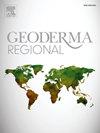黑钙土不同碳库土壤有机质组成的季节变化:作物和施肥的作用
IF 3.3
2区 农林科学
Q2 SOIL SCIENCE
引用次数: 0
摘要
土壤有机质(SOM)是影响土壤大部分功能的重要性质;因此,抽样和调查是必不可少的。然而,即使在农田中,SOM的组成和含量也可能不像假设的那样恒定。研究了施肥和作物类型对采样时间对土壤有机碳(SOC)含量和土壤有机质组成的影响。以匈牙利Martonvásár地区的单黑钙土(Loamic)表层土为研究对象,比较了不同作物条件下施肥对土壤性质的影响。在夏季(2018年8月)和春季(2019年4月)采集土壤样品,研究了大块土壤和两个土壤碳(C)库中的有机碳含量和SOM组成,即矿物相相关有机质(OM)或慢池(附着在颗粒>;63 μm上)和团聚体相关有机质(OM)或快池(被颗粒>;63 μm阻挡)。利用傅里叶变换红外光谱估计了SOM的组成。施肥和作物均不影响土壤有机碳含量和土壤有机质组成。慢池比快池具有更高的SOC含量和更稳定的SOM组成。快速池中SOM活性组分(酰胺态氮和多糖)比例春季高于夏季,而酚类木质素含量降低。不同的植物残留和微生物对总有机碳的贡献可能解释了这些时间变化。因此,土壤采样日期可能会影响土壤有机质含量和组成结果;因此,建议进行重复的季节性采样,以估计SOM性质可能的波动并计算年平均值。本文章由计算机程序翻译,如有差异,请以英文原文为准。
Seasonal changes of soil organic matter composition in separate carbon pools of a cultivated Chernozem: The role of crops and fertilization
Soil organic matter (SOM) is a crucial property affecting most soil functions; thus, sampling and investigation are essential. However, the SOM composition and content may be less constant than assumed, even in crop fields. This study investigated whether fertilization and crop type affect the effect of sampling time on soil organic carbon (SOC) content and SOM composition. A cultivated Haplic Chernozem (Loamic) topsoil in Martonvásár, Hungary, was studied in a long-term experiment to compare the effects of fertilization on soil properties under different crops. Soil samples were collected during summer (August 2018) and spring (April 2019) to study SOC content and SOM composition in the bulk soil and two soil carbon (C) pools, such as the mineral phase-associated organic matter (OM) or slow pool (attached to particles <63 μm) and aggregate-associated OM or fast pool (occluded by particles >63 μm). SOM composition was estimated using Fourier transform infrared spectroscopy. Neither fertilization nor crops affected the SOC content and SOM composition. The slow pool had a higher SOC content and more stable SOM composition than that of the fast pool. Furthermore, the labile SOM component (amide nitrogen, and polysaccharides) ratio was higher during spring than during summer in the fast pool, whereas the phenolic lignin content decreased. Varying plant residual versus microbial contributions to total SOC may explain these temporal variations. Consequently, the soil sampling date may affect the SOM content and composition results; thus, repeated seasonal sampling is suggested to estimate possible fluctuations in SOM properties and calculate the annual average.
求助全文
通过发布文献求助,成功后即可免费获取论文全文。
去求助
来源期刊

Geoderma Regional
Agricultural and Biological Sciences-Soil Science
CiteScore
6.10
自引率
7.30%
发文量
122
审稿时长
76 days
期刊介绍:
Global issues require studies and solutions on national and regional levels. Geoderma Regional focuses on studies that increase understanding and advance our scientific knowledge of soils in all regions of the world. The journal embraces every aspect of soil science and welcomes reviews of regional progress.
 求助内容:
求助内容: 应助结果提醒方式:
应助结果提醒方式:


